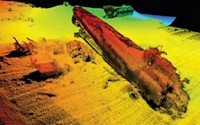Advertisement
Grab your lab coat. Let's get started
Welcome!
Welcome!
Create an account below to get 6 C&EN articles per month, receive newsletters and more - all free.
It seems this is your first time logging in online. Please enter the following information to continue.
As an ACS member you automatically get access to this site. All we need is few more details to create your reading experience.
Not you? Sign in with a different account.
Not you? Sign in with a different account.
ERROR 1
ERROR 1
ERROR 2
ERROR 2
ERROR 2
ERROR 2
ERROR 2
Password and Confirm password must match.
If you have an ACS member number, please enter it here so we can link this account to your membership. (optional)
ERROR 2
ACS values your privacy. By submitting your information, you are gaining access to C&EN and subscribing to our weekly newsletter. We use the information you provide to make your reading experience better, and we will never sell your data to third party members.
Pollution
Boars carry traces of decades-old nuclear weapons tests
Atmospheric testing, Chernobyl fallout contaminate wild boar meat in Germany
by Neil Savage, special to C&EN
September 1, 2023

Wild boar, once a delicacy in Germany and Austria, has been largely off the menu since the Chernobyl power plant meltdown in 1986 spread radioactive waste across Europe, contaminating the meat. While radiation levels in other animals have declined in the ensuing decades, levels in boars have remained mysteriously steady. Researchers tracing the source of the radiation now think they know why (Environ. Sci. Technol., 2023, doi.org/10.1021/acs.est.3c03565).
Researchers from the Leibniz University Hannover and Vienna University of Technology took samples of boar meat gathered in Bavaria and tested it for cesium-135 and cesium-137, using a standard chemical purification technique and a recently developed form of mass spectrometry to obtain the ratio of the elements.
Because of the way the isotopes are produced, the ratio of 135Cs to 137Cs coming from a nuclear reactor tends to be low. Researchers found both low and high ratios, indicating some of the contamination came from atmospheric weapons testing in the 1950s, 60s, and 70s.
Georg Steinhauser, a professor of applied radiochemistry at TU Vienna, says that, because it takes time for cesium to migrate through the soil, the boars who root for wild truffles are getting more of the older contamination from nuclear tests than animals that eat plants on the surface. The moving “front” of Chernobyl contamination has not yet reached truffles.
“It’s still continuing,” he says. “It will be there for many years to come.”





Join the conversation
Contact the reporter
Submit a Letter to the Editor for publication
Engage with us on Twitter